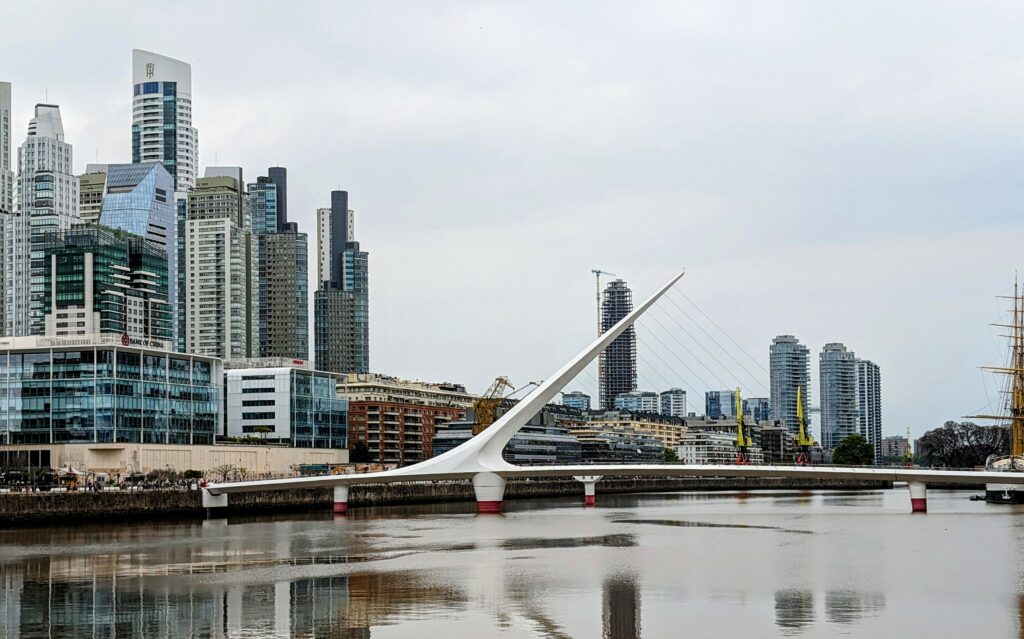
This comes after decades of financial instability and government and banking distrust. With a 140% inflation rate on their currency, Argentines immediately exchange their pesos for dollars, which is a currency that is much more stable. As a result, having dollars is truly a valuable commodity when coming here. Other international currencies also have these favorable exchanges, but they do prioritize US dollars. Everything discussed here can be transferred to other currencies.
Important: Do not, do not, do not get money from an atm or a bank. You will get the government created exchange rate, which is much lower than any other.
Florida Street (or other currency exchanges)
What is FLorida Street?
In the centro of Buenos Aires, you can find Avenida Florida, where many “cambios” are located. These are underground money exchanges where you can get the best rate for your dollars. They exchange at the blue rate, or the true market rate, named after the blue stripe that can be found on a $100 bill. They are based off of market demand for dollar bills. These exchanges prioritize $100 bills and you will get the best rate if you bring those bills with you when visiting Argentina. If you bring more than $500, you will have an even better exchange rate.

So how does this work?
“Arbolitos” (little trees), or people looking to buy dollars (because of the green dollars, leaves) line this pedestrian street. You will hear them calling out “cambio, cambio” while walking. You can go up to a few of them to find out their rate and negotiate. The arbolitos are incredibly persuasive and pushy so don’t be afraid to say no and walk away if you are getting uncomfortable. They will try to walk you to their shops as quickly as possible because you will then be pressured to make the exchange. Do not follow them until you are confident in the exchange.
We like to go into the conversation knowing what to expect. The Nacion (Buenos Aires newspaper) lists the daily exchange rates. Use this site and look for the Dolar Blue compra, or what they are buying a blue dollar for. (The dollar signs on this website indicate the Argentine peso.) So for this screen grab from November 18, 2023, 1 US dollar is being purchased for 900 Argentine pesos. And to give you an idea of what that could purchase on November 18, 2023, a 2 liter water is around 500-800 pesos. When talking to the “arbolitos”, we typically try to get a little over the blue dollar rate listed here.
Your cheat sheet to exchanging money on Florida Street:
- Find the Dolar Blue compra at the Nacion (Buenos Aires newspaper) to know what the expected rate should be.
- Talk to 2-3 arbolitos before making your decision of who you want to go with.
- Bring a large, zippered bag or backpack to carry all the bills you will receive.
Western Unions

Using Credit and Debit Cards
Finally is the use of credit cards. This is a new change as of November 2022. To continue to promote tourism, the government created a new exchange rate when using a foreign credit or debit card. This rate is close to the blue dollar rate and is a great option for convenience. For Visa, this rate automatically processes but with Mastercard, you will receive the reimbursement rate to your card a few days later. I would recommend this method primarily for visa card holders. This does not work at ATMs to withdraw cash!

We learned about the Wise app that allows you to wire money internationally to an account. You then use that account to pay from your phone. It lets you know what the exchange rate is prior to paying so you know what you are spending. Definitely look into it prior to using it to make sure that it aligns with your travel and spending goals. We have never used it but have heard some success stories from people who have. They have said that they receive close to the Blue Dollar rate with this method.

These three methods are the primary methods of exchanging your money within Argentina. While cards seem convenient, we do recommend having some cash on you for tips and for those incredible local places that only accept cash!


